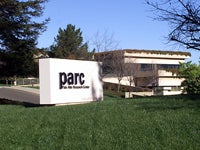 |
Source: Xerox |
PALO ALTO, Calif. — Despite all of the great inventions to come from Xerox’s (NYSE: XRX) Palo Alto Research Center (PARC) — Ethernet, object-oriented programming, the laser printer – it will forever be known as the place where a young Steve Jobs saw the first graphical user interface and was smarter than Xerox executives in seeing its potential.
Well, they are not going to let that happen again.
Spun off from Xerox in 2002 as a wholly owned subsidiary but still independent, PARC is now a research center dedicated not just to dreaming up new technologies but with a much clearer plan about bringing them to market. For starters, if Xerox doesn’t want it then PARC will find a partner that will help it productize the invention.
“No project can get past a certain point without a value proposition,” Mark Bernstein, head of PARC, told InternetNews.com. There will be no sitting on their hands like with the GUI so many years ago. “We are free to pursue other options with all of the projects we have.”
But, he added, there is a purpose to every project. “It’s not like I put an envelope to my head and say ‘today we are going into biofuels,'” Bernstein said. “It’s got to be important. We’re not interested in creating a technology that’s looking for a demand.”
Today, Xerox funds only about 50 percent of the work that goes on with PARC funding the other half through licenses to other corporations, research partnerships and government grants.
On Monday of this week, the company opened the doors to a press day, where it showed off demos of what it has under development. No longer just a development arm for a document firm, PARC is expanding into areas that its former parent company would never consider.
For example, one project called Rare Cell Detection is a joint venture with The Scripps Research Institute, the largest biomedical research center in the country. By using a laser to scan a blood sample, unusual genetic defects are illuminated in certain colors.
This helps to identify metastatic cells before they show up in a MRI or some other intrusive test, like an biopsy. There is also talk of using it to test a pregnant woman’s blood rather than make her undergo the risky amniocentesis. This process is still four or fix years away, according to Richard Bruce, director of the projects for Scripps and PARC.
Another initiative involved developing cost-effective methods of water filtration without a membrane filter. Instead, water is spun through a filter and the particles are separated out as a slurry while much cleaner water comes out.
It still needs some treatment, according to Nitin Parekh, a project lead. But it will eliminate or reduce the need for water-treatment plans to have all of their largest treatment tanks and reduce chemical use by 15 percent.
[cob:Pull_Quote]Parekh’s other project is with SolFocus, a startup that makes solar concentrators. Instead of laying out large mirrors to gather sunlight, the two firms are working on small, cheaper mirrors that concentrate light onto smaller chips. PARC parlayed its knowledge of optics technology into small sun collectors and SolFocus makes the chips that collect the energy.
PARC is partnered with Fuji Xerox out of Japan for an interesting new twist on plastics: biomass materials rather than oil-based products. So plastic is made from corn rather than petroleum.
Researcher Michiaki Yasuno noted that in the overall life span of a copier machine, which is full of plastic, 62 percent of the carbon dioxide emissions come from just making the thing.
Of course, much of that is related to the making plastic, assembly, and transportation. The solution was to make some of the plastics from biomass, particularly corn. It resulted in a 16 percent reduction in CO2
emissions but raised the cost of the part by two to three times. That’s why it’s a lab project.
Still in the documents business
While PARC is expanding beyond documents, it hasn’t abandoned them as research projects. Erasable paper is just one of many document-management projects under development here.
The Intelligent Document Redaction technology can scan a document and automatically black out certain keywords, and words that have a certain association. For example, medical documents must black out references to HIV positive status. The technology can also identify medicines used to treat HIV patients and redact that, too.
Rules can be written to redact information based on keyword, class, category of information or personal information, according to researcher Jessica Staddon. The document can be left readable so human eyes can double-check the redaction, and some documents can be encrypted, so redaction can be removed.
Christopher Dance, head of the Xerox lab in Grenoble, France, showed off smart-document technology designed to add intelligence and context to searches by learning how the words are being used. The first demo was a blog categorizer that could examine pictures, determine their contents and then add tags based on the photo. A photo of the French Alps automatically generated tags such as “France,” “mountains” and “Alps.”
The second was FactSpotter, a semantic technology for search engines that infers whether ambiguous words are being used as nouns or verbs and helps to craft more targeted results.
None of these technologies had anything even close to a release date. Release dates of four, five, six years or more were offered from the different projects. But they will see the light of day eventually and solve a problem, Bernstein said. “Our mission is the marrying of researcher insight with the desire to have a real impact on the world,” he said.


